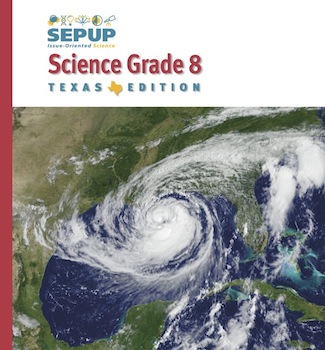SEPUP Science Grade 8: Teacher Links
Online Resources
Select any unit from contents
Unit 1: Ecosystems
See more resources.
^ top
Unit 2: Force and Motion
Activity 16 Interpreting Motion Graphs
Activity 19 Force, Acceleration, and Mass
Activity 20 Inertia Around a Curve
Activity 21 Newton’s Laws of Motion
Activity 26 Crash Testing
Activity 28 Fatal Accidents
Activity 16
Interpreting Motion Graphs
PhET Simulation: Moving Man
Learn about position, velocity and acceleration graphs using this interactive simulation.
Activities 19, 20, 21
FMA Live
This website contains music videos and Power Point presentations of Newton’s Three Laws of Motion. There are additional links to information about Newton’s life and everyday examples of the three laws of motion.
Activity 26
Crash Testing
Crash Test Videos
See how your car would fare in a crash — view crash test videos for recent vehicle types and models. Conducted by the Insurance Institute for Highway Safety (IIHS) the crash tests show several different vehicle types including small cars, SUV’s, and pickup trucks.
National Highway Traffic Safety Administration
Find out why is it important to wear seat belts, put infant seats in the back seat, or never hold an infant on your lap in the car. See video clips of crash test dummies in these situations and many others.
Insurance Institute for Highway Safety Vehicle Research Center
Have you ever wondered how crash test dummies were constructed or how the vehicle safety rating were determined? Read about these topics and how the Insurance Institute for Highway Safety (IIHS) tests vehicles to determine safety ratings.
Activity 28
Fatal Accidents
US Census: 2012 Statistical Abstract
Latest accident statistics from the government.
^ top
Unit 3: The Chemistry of Materials

Activity 30 The Impact of Electronic Products
Activity 31 Families of Elements
Activity 32 Elements and the Periodic Table
Activity 37 Producing Circuit Boards
Activity 41 Reclaiming the Copper
Activity 30
The Impact of Electronic Products
Electronics Recycling and Waste Reduction—Texas Commission on Environmental Quality
State Legislation—Electronics Takeback Program
Electronics/Recycling in the Lone Star State
Basic Information: Green Chemistry from The United States Environmental Protection Agency
The Green Chemistry Institute by the American Chemical Society
“Green Chemistry Takes Root” by Elizabeth Weise. USA Today, November 22, 2004.
The Great e-waste Recycling Debate
Activity 31
Families of Elements
Los Alamos National Laboratory Periodic Table of the Elements
IUPAC – International Union of Pure and Applied Chemistry: Periodic Table of the Elements
Click on “Periodic Table of the Elements” to download the latest version of the table approved by the International Union of Pure and Applied Chemists (IUPAC).
Activity 32
Elements and the Periodic Table
History of the Periodic Table of Elements and the work of Dmitiri Mendeleev
Dmitiri Mendeleev Online
Maintained by Eugene V. Babaev at Moscow State University.
Multilingual dictionary of the names of chemical elements
This website lists the names of elements in more than twenty languages.
Activity 37
Producing Circuit Boards
Consumer Fact sheet on Copper
This website by the U.S Environmental Protection Agency – Office of Ground Water and Drinking Water provides basic information about copper in drinking water.
Activity 41
Reclaiming the Copper
Current Primary and Metal Scrap Prices can be found at:
Metalprices.com
The London Metal Exchange
^ top
Unit 4: The Earth and Weather
Activity 43 Natural Disasters
Activity 50 Oceans and Climate
Activity 51 The Causes of Climate
Activity 52 Measuring Wind Speed and Direction
Activity 55 Observing the Earth from Space
Activity 58 The Theory of Plate Tectonics
Activity 43
Natural Disasters
Activity 50
Oceans and Climate
Activity 51
The Causes of Climate
Be the first to post your class’s predictions on how the climate in your area might change. Email us a pdf of your students’ predictions and we’ll post them on our website!
Activity 52
Measuring Wind Speed and Direction
Using a Psychrometer to Measure Relative Humidity
Activity 55
Observing the Earth from Space
Activity 58
The Theory of Plate Tectonics
Video Segment 1 – Plate Tectonics: The Scientist Behind the Theory
This video segment chronicles the Alfred Wegener’s development of the theory of continental drift and is from the WGBH Teacher’s Domain website. It is recommended that you have the latest version of QuickTime installed to properly view this video.
Video Segment 2 – Plate Tectonics Further Evidence
Using evidence from Alfred Wegener’s theory of continental drift, this video on the WGBH Teacher’s Domain website details the evidence that supported the theory of plate tectonics. It is recommended that you have the latest version of QuickTime installed to properly view this video.
^ top
Unit 5: Cycles and Seasons
Activity 66 As Earth Rotates
Activity 67 Sunlight and Seasons
Activity 68 A Year Viewed From Space
Activity 70 The Earth on the Move
Activity 71 The Predictable Moon
Activity 73 Moon Phase Simulator
Activity 74 Tides and the Moon
Activity 75 Marking Time
Activity 66
As Earth Rotates
The North American Sundial Society
This site provides answers to questions about sundials and gives information about how to make or set up your own sundial. It also provides references and links to other sites.
Making a Sun Clock
This site from the Exploratorium tells you how to make a simple sun clock.
A Walk Through Time
This site of the National Institute for Standards and Technology provides information on both ancient and modern methods for measuring time.
Educational Exhibits about time, clocks, daylight savings, or calendars
This site lists the official U.S. time and has links to additional sites about time.
Activity 67
Sunlight and Seasons
Sun-Earth Day 2005—Ancient Observatories
This NASA site contains links to a timeline and photographs of ancient structures used to observe the Sun and indicate the seasons.
Activity 68
A Year Viewed from Space
SEPUP Seasons Interactive
Use this link to explore the seasons on Earth as viewed from space.
Activity 70
The Earth on the Move
Seasons Reasons
This NASA site explains the seasons and includes an animation.
Seasons
The animation at this site shows the change in seasons as the Earth orbits the Sun.
Activity 71
The Predictable Moon
Virtual Reality Moon Phase Pictures
This site of the United States Naval Observatory provides virtual views of the Moon for any date in the past or future.
Earth View
This site provides today’s view of the Moon.
Activity 73
Moon Phase Simulator
Moon Phase Simulator
Simulation not running properly? Make sure you have the latest version of Java installed.
The United States Naval Observatory Eclipse Home Page
This site provides information about eclipses of the Sun (solar eclipses) and the Moon (lunar eclipses).
Activity 74
Tides and the Moon
NOAA: Tide Animation
This animation from the National Oceanic and Atmospheric Administration of the Moon’s rotation around Earth helps you understand how the phase of the Moon relates to extreme tides.
Tide Region Selection
This site allows you to look up tides at numerous sites in the United States.
Activity 75
Marking Time
Calendars and their History
This site provides information on the history and astronomical basis of calendars. It includes information on the Gregorian, Julian, Jewish, Islamic, Indian, and Chinese calendars.
The Classic Maya Calendar and Day Numbering System
^ top
Unit 6: The Universe
Activity 78 Modeling the Milky Way
Activity 80 Star Classification
Activity 83 Measuring the Universe
Activity 84 The Dynamic Universe
Activity 85 Future Research
Activity 78
Modeling the Milky Way
Explore the Milky Way
This website provides a 3-D Model of the Milky Way
Activity 80
Star Classification
The Classification of Stars
A diagram that shows most of the major types of stars.
Activity 83
Measuring the Universe
Evidence for the Big Bang
This short video excerpt adapted from Nova describes the work of Arno Penzias and Robert Wilson.
Activity 84
The Dynamic Universe
Astronomy for Kids: Redshift
An explanation of redshift geared for a student audience.
Galactic Redshift Simulator
Simulate how a spectrum changes based on a galaxy’s redshift.
Activity 85
Future Research
Cryogenic Dark Matter Search II (CDMS)
Fermi Gamma-Ray Space Telescope
^ top

